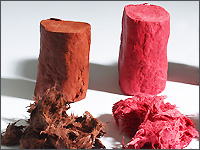| Home > Material > Occasionally Used Materials > Epoxy |
Epoxy |
Epoxy, also called polepoxide, is a a highly cross-linked thermosetting polymer which is produced when the epoxide resin reacts with a polyamine hardener. These polymers possess excellent electrical properties, low shrinkage, good adhesion to many metals and resistance to moisture, thermal and mechanical shock. Most common epoxy resins are produced from a reaction between epichlorohydrin and bisphenol-A.

Chemistry of Epoxy
A copolymer, epoxy comprises of two different chemicals: the resin and the hardener. Each resin molecule is made up of monomers or short chain polymers with an attached epoxide group attached at either end. The epoxide group also referred to as oxirane or ethoxyline group sometimes. There are two types of resins are :
- Glycidyl epoxy resins
- Non-glycidyl epoxy resins : further divided into Glycidyl-ether, Glycidyl-ester and Glycidyl-amine.
The hardeners used are generally made up of polyamine monomers and can be classified under two major types :
- Amine based curing agents
- Phenolic novolac resins
A wide variety of both the hardener and the resin are available, the choice basically depends upon the process selected and the desired properties of the polymer.
Epoxy in Engineering applications
 Although these resins display excellent electrical and adhesion properties, they are brittle in nature and have poor thermal conductivity, which limits their usage in lot of engineering applications. There are several methods which can be employed to increase the the toughness and strength of these resins. A few approaches are as follows : Although these resins display excellent electrical and adhesion properties, they are brittle in nature and have poor thermal conductivity, which limits their usage in lot of engineering applications. There are several methods which can be employed to increase the the toughness and strength of these resins. A few approaches are as follows :
- Chemical modification of the epoxy backbone to enhance the flexibility of the structure.
- Increasing the molecular weight of epoxy.
- Lowering the cross-link density of matrix.
- Incorporating dispersed toughener phase in the cured polymer matrix.
- Incorporating inorganic fillers into the neat resin.
|
| |
| |
 |
